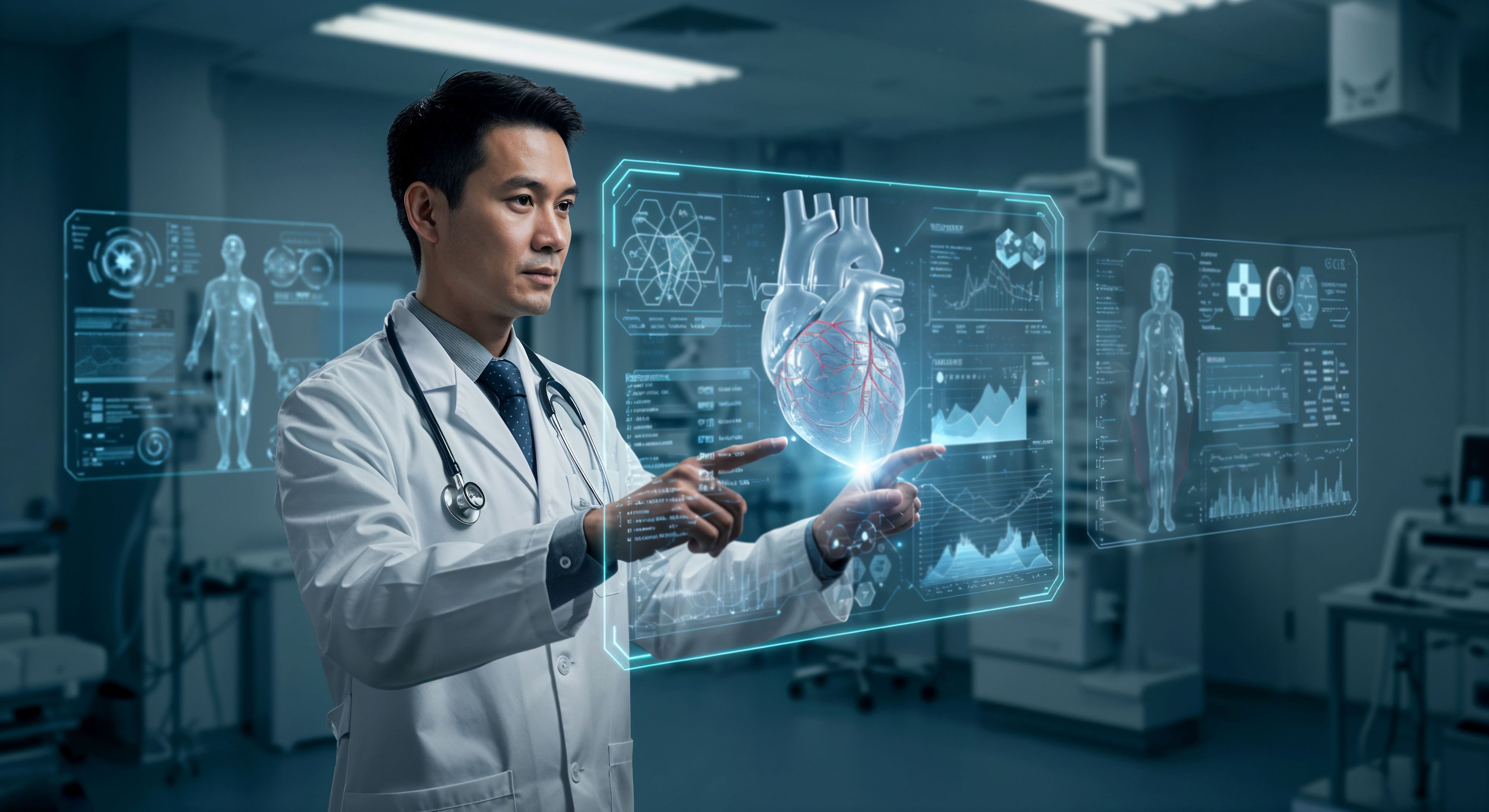Not long ago, seeing a doctor meant waiting in a crowded clinic. Test results could take days, or even weeks. Managing a chronic illness like diabetes or high blood pressure – often involves juggling multiple appointments, prescriptions, and paper records.
Today, that experience is changing.
You can consult your doctor over a video call, get medication delivered to your door, and receive AI-powered health insights in real time with a smartwatch or home monitoring device. Whether it’s managing a long-term condition or simply staying on top of your wellness goals, technology is making healthcare more convenient, connected, and personal.

What’s driving this is a powerful shift: care is becoming more patient-centric.
The digital health revolution is here, and it’s redefining the way care is delivered to patients. Digital health devices and platforms, powered by data-driven insights, are making care more accessible, personal and continuous.
This transformation spans across telemedicine, remote patient monitoring, wearable health devices, and the use of AI in medical diagnoses. While this shift opens up exciting possibilities, it also raises important challenges. How do we protect patient data and privacy? How can we ensure health equity and digital inclusion, especially in underserved communities? And how do we scale these innovations sustainably?
In this article, we explore key trends and emerging technologies that are driving the global digital health transformation, and what it all means for the future of care.
Key trends in digital health
In its Digital Health Strategy 2020-2025, the World Health Organisation defined digital health as the use of digital technologies and data to improve health outcomes, and empower individuals to take charge of their well-being.
At its core, digital health puts people, not just processes, at the centre of care. And around the world, this shift is already taking shape through a wave of innovation. Here are some examples:
1. Wearable technologies
Devices like smartwatches, continuous glucose monitors, and electrocardiogram (ECG) trackers now provide real-time insights into heart rate, sleep quality, blood oxygen levels, and more.
These tools are empowering people to take a more active role in managing their health, by helping detect potential issues earlier and encouraging healthier habits. For example, the Apple Watch can now alert wearers to irregular heart rhythms, potentially catching problems before symptoms appear.
2. Telemedicine
The adoption of telemedicine has skyrocketed in recent years. Digital platforms now allow patients to consult a doctor, receive prescriptions, and manage follow-ups, all from their phone or laptop. This enables patients to reduce unnecessary in-person visits and wait times.
3. Mobile health apps
Ranging from fitness and nutrition tracking to chronic disease management, these smartphone apps allow users to monitor their conditions, set goals, and access educational content, often in real time. They also contribute to a growing pool of anonymised health data, which can support research, improve public health strategies, and guide policy decisions.
4. Remote patient monitoring
Remote patient monitoring solutions are a game-changer for people with chronic conditions like diabetes, hypertension, and heart disease. Patients will be able to share real-time health data with their healthcare providers, enabling early intervention and preventing hospitalisation.
5. Digital startups
Across the world, digital health startups are playing a vital role in making healthcare more efficient, scalable, and patient-focused. Examples of solutions they provide are AI-powered diagnostic tools and digital platforms that simplify appointment booking and medical record management.
Many also pioneer the use of artificial intelligence (AI) in clinical decision support, improving diagnostic accuracy and helping clinicians detect diseases earlier. Others use generative AI to support patient communication or automate administrative tasks.

Better care, every step of the way
Beyond just the adoption of technological tools, digital health is about rethinking the entire care experience for patients.
For example, in the past, getting a diagnosis would involve multiple trips to the clinic, long waits, and repeated tests. Digital health is changing that. With electronic health records, doctors can now access a patient’s full medical history –including medications, previous treatments, and test results – in just a few clicks. This helps them make better-informed decisions, thereby reducing the chances of misdiagnosis. Beyond just the adoption of technological tools, digital health is about rethinking the entire care experience for patients.
And thanks to AI-powered tools, healthcare professionals can now detect diseases faster and more accurately. In radiology, AI is trained to spot abnormalities in scans. Sometimes, they can even do so earlier than the human eye is able to. This kind of early detection is already making a difference in fields like oncology, where catching cancer in its early stages can be lifesaving.
With the rise of personalised medicine using genomics, doctors can also tailor treatments to your unique genetic makeup. This means fewer side effects, better outcomes, and a greater chance that the medication or therapy will actually work for you.
Extending care beyond hospital walls
A global shortage of at least ten million healthcare workers is expected in 2030, according to the World Health Organisation, with upper estimates of over 78 million.
This threatens not only the quality, but also the access of care, particularly in already underserved communities.
And currently, nearly 60 percent of the global population – approximately 4.5 billion people – lack access to essential health services. What this means is that improving healthcare delivery is now a necessity.
Digital health technologies are helping to close this gap, a McKinsey report notes. By making care more efficient, accessible, and cost-effective, they help ease the pressure on overstretched systems.
For many patients in rural or remote communities, or individuals with mobility issues, even a routine clinic visit can be a challenge. But with the rise of telemedicine and remote patient monitoring solutions, those barriers are starting to fall.
The benefits also go beyond convenience. Virtual consultations reduce unnecessary emergency room visits, while remote monitoring tools can detect warning signs early, allowing for timely intervention and reducing the risk of complications. At the same time, digital platforms automate admin tasks and streamline workflows, so that healthcare professionals can spend less time on paperwork and focus on what matters most: their patients.
Scaling digital health also means growing the workforce behind it.
The same McKinsey report highlights the importance of rethinking training programmes for healthcare talents – such as shortening or restructuring some courses, as well as embracing new teaching methods and tools. Think VR simulations that let nursing students practise procedures in realistic environments; or AI-powered learning platforms that adapt to each trainee’s pace and knowledge gaps. Scalable, tech-enabled approaches, like mobile apps and blended learning programmes, can also help boost training outcomes.
Digital health in Singapore: Shifting care from hospitals to homes
As the population ages and chronic conditions like diabetes and high blood pressure become more common, Singapore has embarked on a nationwide effort – called Healthier SG – to shift care from hospitals to homes and communities. And technology is a key aspect that’s making this possible.
Using the HealthHub App, residents can easily book appointments with their preferred clinic, view medical records, and even help manage a family member’s care as a caregiver. They can also work with their doctors to co-create a personalised health plan.
The Healthy 356 App helps residents understand their overall health status and in taking actionable steps towards their health goals as planned. It can be used to track daily physical activity, sleep duration and calorie intake. The app also incentivises healthy lifestyle choices using gamification methods and can be integrated with other digital health apps on wearable devices to nudge residents towards healthier lifestyles.
While telemedicine in Singapore isn’t new, it gained serious traction since the Covid-19 pandemic. People recovering at home could check in with doctors remotely, and many realised how convenient, safe, and effective it could be. It’s particularly helpful for seniors, those with mobility challenges, or anyone managing a long-term condition. Now, patients can easily speak with their doctors over a video call, have medication delivered to your doorstep, or monitor their conditions using smart devices.
Singapore’s Ministry of Health is also looking into scaling the use of generative AI tools to automate tasks, like documentation and summarisation of medical records. This will allow healthcare professionals to spend more time caring for patients, and be less occupied with routine tasks.
What’s next? Your health, in your hands
We’re entering an era where care comes to you, according to a Boston Consulting Group report.
Wearable devices will help monitor heart conditions, track recovery after surgery, and alert doctors before something becomes serious; virtual hospital wards will keep patients safely monitored from home, reducing the need for in-person hospital visits. AI-driven medical devices are also moving beyond diagnostics. They will integrate with wearables, remote monitoring tools, and predictive analytics, allowing health systems to shift from reactive treatment to proactive care.
At the heart of all these: The patient.
These digital health innovations are designed to put people in control of their health journey. And unlike in the past, patients will no longer be passive recipients of care. Instead, they’ll be empowered to make informed decisions about their own health, with providers supporting them every step of the way.
Khoong Chan Meng, CEO of NUS-ISS, believes that technology must serve a more human purpose. “The future of healthcare lies in empowering people to take charge of their own well-being. As care becomes more digital, it must also become more personal, more inclusive and more human. At NUS-ISS, we believe in building capabilities that drive this transformation responsibly and at scale.”
These shifts mark more than just a technological upgrade. They signal a transformation in how we view, deliver, and experience care. As digital health continues to evolve, the real opportunity lies in building a future where every individual is empowered, every provider is equipped, and every system is designed to put people first.
Sign up for the inaugural run of the Digital Lean for Health Services, an online Blended Learning programme here. To learn more about NUS-ISS Online Blended Learning Programmes and its courses, please click here.